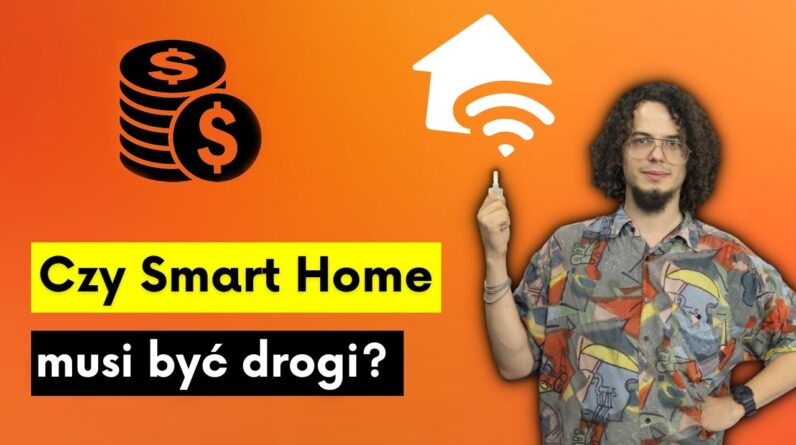
Did you know that the temperature and light in your apartment can
think in your place? Many of you have certainly encountered
the problem of flooding or fire. Can it be avoided with technology? Let's check it. What is Smart Home?
First of all, we should associate this concept with energy saving, comfort,
security and the Internet of Things. First things first.
I press the button. The light goes out, the blinds go down
and the multimedia devices finish their work.
It is all a reaction to
pressing one button. This is what we call a macro scene. We can adapt the scenes to a specific time of the day or what
we are just going to do. An intelligent house can adapt
to our work, sleep or rest. The question is, is such a
house right for you? Perhaps building automation is associated with some incredibly expensive luxury,
directed rather at the wealthy. Then you can surprise yourself! A starter kit from Xiaomi, working on WiFi or ZigBee,
you can get even for PLN 300/400 and at this price, in addition to the control unit, you
also get switches and sensors. Smart Home is becoming more and more
popular and various companies are expanding their offer so that it reaches a
wider audience.
Examples are such mega-corporations
as Google, Apple and Amazon. Remember how in one of the last episodes of our news
we talked about the Matter translation? If you are unfamiliar with AV iT News, take
a look at our Channel. But going back to Matter, it is supposed to be a standard developed, among others,
by the above companies, which in practice will unify
smart homes for programmers. Everything for our convenience. Alexa, Google Home or Apple
HomeKit are systems that enable the integration of smart
devices in our home. We will expand on the issues of standards in a moment, and in the meantime let
's talk about savings. Smart Home saves. Do you know how Smart Home
helps us save? We save energy, among other things,
thanks to intelligent lighting management, as well as
devices in our home. Smart Home, as the name
suggests, is intelligent. This means that our house or apartment
knows perfectly well when we are at work, home, and even in what
room we spend our time. Thanks to this, we can save a lot of energy by automatically adjusting
lighting or temperature.
Probably everyone who pays attention to saving, makes sure that appliances that
use electricity do not work if no one uses them. We turn off the computer when we finish work, the TV
when we are not watching, the console when we finish playing, or the light when no
one is using the room. An intelligent house can control our devices and thus optimize
energy consumption not only by eye, as we do, but in the most
cost-effective way possible for us. We just delegate
our task to the computer. The case of convenience is quite similar. As I mentioned before, the fact that our home is intelligent means
that it knows quite a lot about us. And that, in turn, means convenience. The natural consequence of the development of technology
is the automation of certain activities. Machines do things for us humans. Our house can also think for us. Adjusting the temperature in the room, watering the garden or simply remote
control over our home are the amenities that
smart devices bring with them.
Since the house does it for us, we can actually delegate some of our duties
to be performed by our house. What about flooding? Or by smoking? Or maybe with a burglary? It is true that we live in a relatively safe country, but accidents
happen to everyone. Exactly. And our smart home can not only
help prevent such accidents, but also
minimize the damage if necessary. Imagine finding out about a
potential water damage, burglary or other hazard
while you are away from home. The possibility of immediate intervention or
notification of appropriate services significantly increases the chances of
protecting our property. Do you want to maximize your
sense of security? Automating your place of residence
gives really great results.
And pay attention to it when
securing your achievements. A few more words about the Internet of
Things, i.e. IoT.
If these words sound enigmatic to some of you ,
I am in a hurry to explain. When we talk about the internet, we
mean human-machine communication. The machine can be a computer,
smartphone, smart TV , whatever. It is a person who writes an
e-mail and reads the e-mail, and the Internet only acts as an intermediary in transmitting the message. When we talk about IoT,
or the Internet of Things. We mean
machine-machine communication. The moisture sensor sends a message to the sprinkler, so it knows
when to water the flowers in the garden. An intelligent thermometer sends information to the air conditioner, which
will adjust the temperature itself, etc.

In the Internet of Things, it is things
, not people, that communicate with each other. But Szymon, if he buys a smart
bulb on WiFi that changes colors, a vacuum cleaner that will vacuum for me, a
washing machine, a refrigerator, anything with a note "smart" on a store shelf
, will my home be smart? Well, not really. If you want to live in a smart home, you have to
start by choosing a standard. Generally,
wired and wireless standards are available. Simply put, wired ones,
such as KNX or Loxone, are more expensive. This is due to the fact that the electrics in the building
must be planned with a given automation system in mind, which usually
involves a general renovation. So if we're building a new home or planning a major renovation,
wired standards will be a great option. Their main advantage is stability. Cable is the most stable connection medium so far. Once it gets done,
it just works. KNX is the most popular building automation standard and has become, in a
sense, synonymous with the smart home.
Thanks to this, we have a wide selection of devices from various manufacturers,
such as Satel or Gira. Loxone is a rather closed standard. This is both a downside and an advantage. The obvious disadvantage is the lack of such an extensive
base of devices and manufacturers as in the case of KNX, but the
closed system has a much more transparent monetization method and devices from the
same manufacturer are produced with a view to working with specific devices
, including the ecosystem. Loxone declares that thanks to this system we are able to
save up to 51% of heating costs. Among the wired standards we can also find, among others Ampio. Ampio, in turn,
is based on the CAN bus.
The CAN bus also has pros and cons. The upside is that
it takes off instantly. Standard does not have an operating system, which makes it really easy to get up and
running. Of the minuses, it should be mentioned that we need wire connections between
each switch and modules in the switchboard. This is due to the fact that the modules in the
bus system are mounted on such a rail. Something for something. Wired systems are behind us, we are
moving to wireless systems. And here's the first good news. Wireless systems are much cheaper. If you are not planning a general renovation and you just want your house or
apartment to become smarter at low cost, this is something you
should totally hit. Let's start with Supla. Supla is an open source system developed by home automation enthusiasts
and can even run on your WiFi network. Literally, you can run Suple from Raspberry Pi or Arduino and
connect with drivers, eg Zamela. If you like DIY, it can be an
interesting task for you that will allow you to budgetly design an intelligent
home in exactly the way you want.
Wireless systems usually offer
more options when it comes to building a system from
scratch on a Do It Yourself basis. You can design many things
yourself, having the right equipment. This does not mean, however, that when you decide to use wireless systems, you are
doomed to DIY. Standards such as Fibaro are rather intended for installation
by certified installers. The point is simply that if you like DIY and want to make your
own smart home, then in wireless systems you have much
more possibilities in this regard. But but!
The Wi-Fi network is not a standard designed for
wireless home automation.
Devices based on ZigBee and Z-Wave will perform much better. For example, RTI devices are based on ZigBee . It is a powerful American company
dealing generally with smart devices. In Poland, however, it is not so
popular, but it enables the automation of lighting or the integration of
devices and control of AV equipment.
In turn, Z-Wave is a more modern wireless standard, it is not as open as ZigBee, but it is much more stable. We can use devices from companies such as Grenton, Fibaro or the
aforementioned Zamel. Another use of wireless standards is also to extend the
functionality of wired standards. We can connect wired and wireless devices,
but maybe we'll talk about it in the next episodes, because in this episode we only
touched on the subject of a smart home.
A topic that we will develop on the Channel. So as you can see, the possibilities
for Smart Home are gigantic. You can make a Smart Home in your place of
residence, regardless of whether you live in a house,
a block of flats or a tenement house. You can spend a fortune packing
electronics in virtually every corner of your room, or fit into a few
hundred for a basic energy optimization
or security. What else would you like to
see in this series? Maybe specific questions
about Smart Home? Would you like to see an
interview with an installer of such devices or a representative of
a building automation company? Or maybe we have to record a guide for you? Be sure to let us know in the comments! Also, don't forget to subscribe to
our Channel and get your hands up. See you later!
Hi!.
As an Amazon Associate I earn from qualifying purchases.







